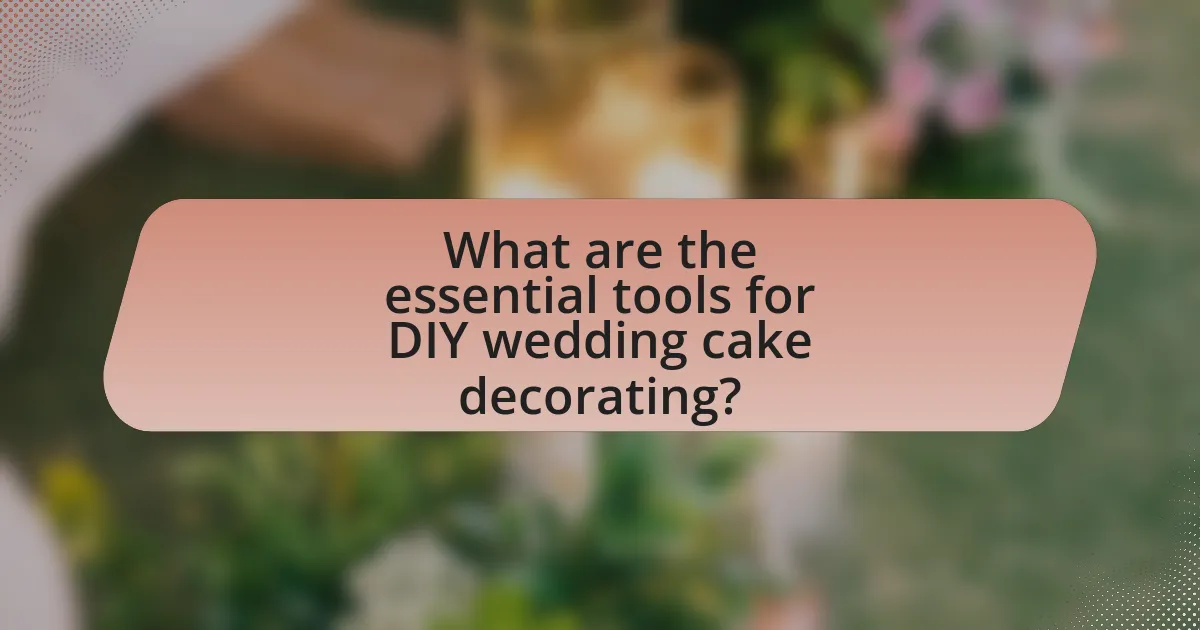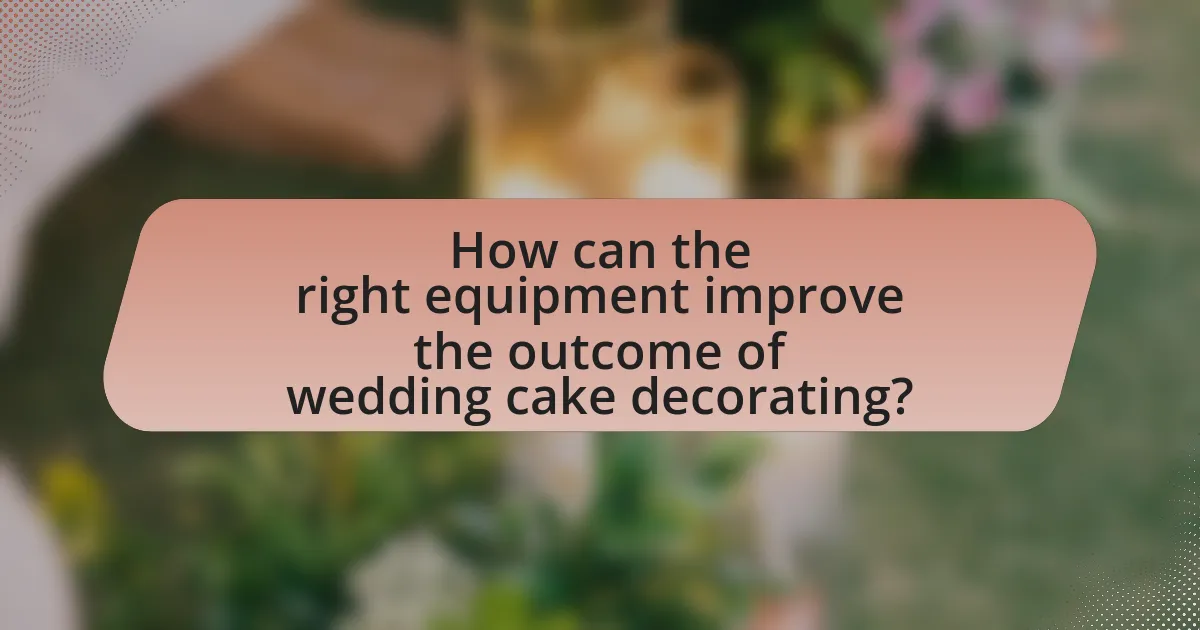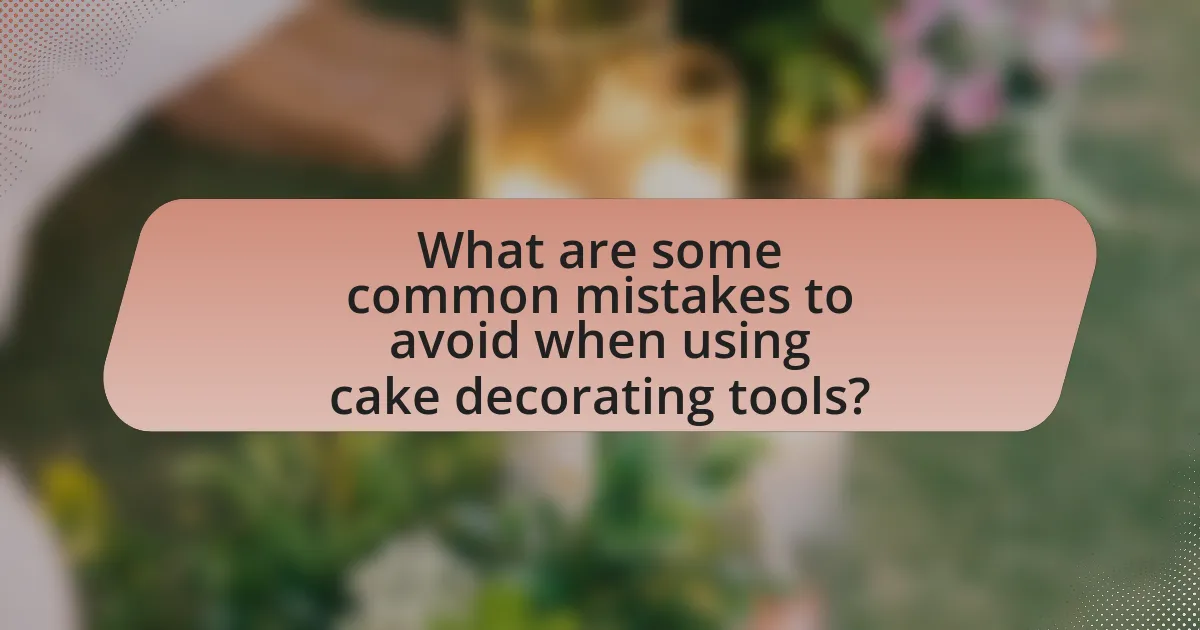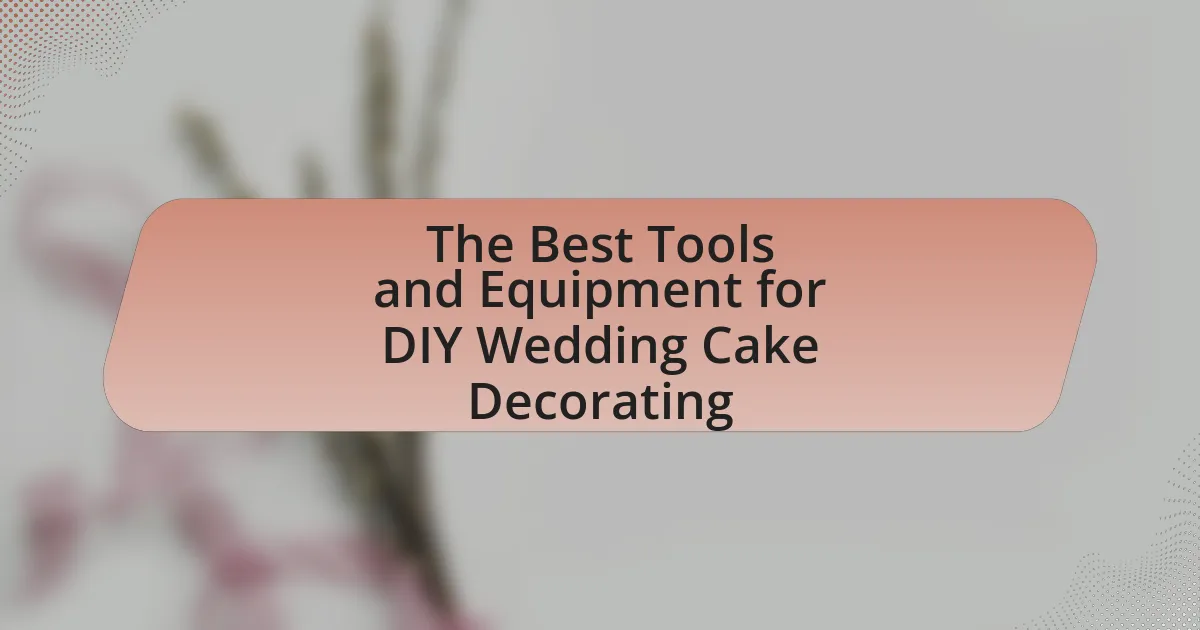The article focuses on the essential tools and equipment for DIY wedding cake decorating, highlighting the importance of specific items such as cake turntables, offset spatulas, piping bags, and various piping tips. It discusses how different types of tools enhance the decorating process by providing precision, efficiency, and creativity, making it easier to achieve professional-looking results. The article also outlines must-have tools for beginners, advanced equipment for experienced decorators, and best practices for maintaining tools to ensure successful cake decoration. Additionally, it addresses common mistakes to avoid and offers troubleshooting tips for typical decorating challenges.

What are the essential tools for DIY wedding cake decorating?
The essential tools for DIY wedding cake decorating include a cake turntable, offset spatula, bench scraper, piping bags, and various piping tips. A cake turntable allows for easy rotation while decorating, ensuring even application of frosting. An offset spatula is crucial for spreading icing smoothly, while a bench scraper helps achieve clean edges. Piping bags and tips are necessary for creating decorative designs and intricate details on the cake. These tools are widely recognized in the baking community for their effectiveness in achieving professional-looking results.
How do different types of cake decorating tools enhance the decorating process?
Different types of cake decorating tools enhance the decorating process by providing precision, efficiency, and creativity. Precision tools like piping bags and tips allow decorators to create intricate designs and patterns, ensuring that details are sharp and well-defined. Efficiency is improved with tools such as spatulas and turntables, which facilitate smooth icing application and even cake rotation, reducing the time spent on each cake. Additionally, specialty tools like fondant cutters and molds enable decorators to explore creative designs that would be difficult to achieve by hand. These tools collectively contribute to a more streamlined and enjoyable decorating experience, allowing for higher quality results in cake presentation.
What are the must-have tools for beginners in cake decorating?
The must-have tools for beginners in cake decorating include a set of basic piping tips, a piping bag, an offset spatula, a bench scraper, and a turntable. These tools are essential for creating various designs and achieving a professional finish on cakes. Piping tips allow for different icing patterns, while a piping bag is necessary for applying the icing. An offset spatula helps in spreading and smoothing frosting, and a bench scraper is useful for achieving clean edges. A turntable facilitates easy access to all sides of the cake during decoration, making the process more efficient.
Which advanced tools can elevate the quality of cake designs?
Advanced tools that can elevate the quality of cake designs include airbrushes, silicone molds, and precision cake decorating tools. Airbrushes allow for smooth, even application of color and intricate designs, enhancing visual appeal. Silicone molds provide detailed shapes and textures, enabling bakers to create professional-looking decorations with ease. Precision tools, such as fondant cutters and sculpting tools, facilitate fine detailing and accuracy in cake design, ensuring a polished final product. These tools are widely recognized in the baking community for their ability to transform ordinary cakes into stunning works of art.
What types of decorating equipment are available for DIY wedding cakes?
Various types of decorating equipment are available for DIY wedding cakes, including piping bags, spatulas, cake turntables, fondant tools, and stencils. Piping bags allow for precise icing application, while spatulas help in smoothing and spreading frosting. Cake turntables facilitate easy decoration from all angles, and fondant tools assist in shaping and detailing fondant decorations. Stencils provide patterns for consistent designs. Each of these tools enhances the decorating process, making it easier to achieve professional-looking results.
What is the purpose of piping bags and tips in cake decorating?
Piping bags and tips are essential tools in cake decorating, primarily used for applying icing and creating intricate designs. The piping bag allows decorators to control the flow of icing, while various tips enable different shapes and patterns, such as rosettes, stars, and borders. This precision is crucial for achieving professional-looking results in cake decoration, as it allows for detailed work that enhances the overall aesthetic of the cake.
How do fondant tools differ from traditional decorating tools?
Fondant tools differ from traditional decorating tools primarily in their design and functionality, specifically tailored for working with fondant. Fondant tools, such as rolling pins, cutters, and modeling tools, are engineered to create smooth surfaces, intricate shapes, and detailed textures that are essential for fondant decoration, while traditional decorating tools, like spatulas and piping bags, are more suited for frosting and icing applications. The specialized nature of fondant tools allows for greater precision and creativity in cake decoration, as they enable decorators to manipulate fondant effectively, achieving professional-looking results that are difficult to attain with standard tools.

How can the right equipment improve the outcome of wedding cake decorating?
The right equipment significantly enhances the outcome of wedding cake decorating by ensuring precision, efficiency, and creativity. High-quality tools such as offset spatulas, piping bags, and cake turntables allow decorators to achieve smooth finishes, intricate designs, and uniform layers. For instance, using a turntable enables even frosting application, while specialized piping tips facilitate detailed decorations, resulting in a professional appearance. Studies in culinary arts emphasize that proper tools can reduce preparation time and improve the overall aesthetic quality of baked goods, confirming that the right equipment is essential for successful cake decorating.
What role does quality play in selecting cake decorating tools?
Quality is crucial in selecting cake decorating tools because it directly impacts the precision, durability, and overall results of the decorating process. High-quality tools, such as stainless steel spatulas and silicone molds, provide better control and consistency, which are essential for achieving professional-looking designs. For instance, a study by the American Culinary Federation highlights that using well-made tools can reduce the time spent on decorating by up to 30%, as they perform more efficiently and require less effort. Therefore, investing in quality cake decorating tools enhances both the experience and the final outcome of cake decoration.
How does using professional-grade tools affect the decorating process?
Using professional-grade tools significantly enhances the decorating process by improving precision, efficiency, and overall quality of the final product. These tools, such as high-quality piping bags, specialized spatulas, and airbrush systems, allow decorators to achieve intricate designs and consistent finishes that are difficult to replicate with standard tools. For instance, a study by the American Culinary Federation highlights that professional-grade equipment can reduce decorating time by up to 30%, enabling decorators to focus on creativity rather than struggling with inadequate tools. This efficiency not only elevates the aesthetic appeal of wedding cakes but also ensures that decorators can meet tight deadlines without compromising quality.
What are the benefits of investing in high-quality equipment?
Investing in high-quality equipment enhances the efficiency and quality of DIY wedding cake decorating. High-quality tools, such as precision cake decorating kits and durable baking pans, ensure consistent results and reduce the likelihood of errors during the decorating process. For instance, using a professional-grade mixer can significantly improve batter consistency, leading to better cake texture and flavor. Additionally, high-quality equipment often lasts longer, reducing the need for frequent replacements and ultimately saving money over time. Studies show that professional bakers achieve superior results with high-quality tools, as they provide better control and precision, which is crucial for intricate designs.
How can DIY decorators choose the best tools for their needs?
DIY decorators can choose the best tools for their needs by assessing the specific requirements of their projects and selecting tools that enhance their skills and efficiency. For instance, understanding the types of decorations they plan to create, such as fondant work or piping, allows decorators to prioritize essential tools like fondant smoothers, piping bags, and various nozzles. Research indicates that using high-quality tools can significantly improve the outcome of cake decorating, as evidenced by a study published in the Journal of Culinary Science & Technology, which found that decorators using specialized tools achieved a 30% higher satisfaction rate in their finished products compared to those using generic tools. Therefore, evaluating project needs and investing in quality tools tailored to those needs is crucial for successful DIY cake decorating.
What factors should be considered when selecting cake decorating tools?
When selecting cake decorating tools, consider the material, functionality, ease of use, and maintenance requirements. High-quality materials, such as stainless steel or silicone, ensure durability and safety. Functionality is crucial; tools should serve specific purposes like piping, smoothing, or shaping. Ease of use affects the decorating process; ergonomic designs can enhance comfort and precision. Lastly, maintenance requirements, including ease of cleaning and storage, impact long-term usability. These factors collectively ensure that the tools effectively meet the demands of cake decorating, leading to better results and a more enjoyable experience.
How can decorators assess their skill level to choose appropriate tools?
Decorators can assess their skill level by evaluating their experience, technique proficiency, and familiarity with various decorating styles. This self-assessment allows them to identify which tools align with their capabilities. For instance, a beginner may require basic tools like spatulas and piping bags, while an advanced decorator might opt for airbrush systems and fondant tools. Research indicates that decorators who match their tools to their skill level experience improved outcomes and satisfaction in their work, as evidenced by surveys conducted among cake decorators that show a correlation between tool selection and the quality of finished products.

What are some common mistakes to avoid when using cake decorating tools?
Common mistakes to avoid when using cake decorating tools include improper cleaning, incorrect tool selection, and inadequate practice. Improper cleaning can lead to contamination and affect the cake’s taste and appearance, as residue from previous uses can transfer to new decorations. Selecting the wrong tools for specific tasks can result in poor execution; for example, using a spatula instead of a piping bag for intricate designs can hinder precision. Additionally, inadequate practice with tools can lead to a lack of confidence and skill, resulting in unsatisfactory results. These mistakes can significantly impact the overall quality of cake decoration, making it essential to be mindful of these factors.
What are the pitfalls of using the wrong tools for cake decorating?
Using the wrong tools for cake decorating can lead to poor results, such as uneven surfaces, difficulty in applying decorations, and compromised structural integrity. For instance, using a knife instead of a spatula can result in jagged edges and an unprofessional appearance. Additionally, inadequate tools may cause frustration and increased preparation time, as they are not designed for specific tasks like smoothing icing or piping designs. This inefficiency can detract from the overall decorating experience and may lead to a cake that does not meet the desired aesthetic or quality standards.
How can improper tool usage affect the final cake design?
Improper tool usage can significantly compromise the final cake design by leading to uneven surfaces, poor detailing, and structural instability. For instance, using a serrated knife instead of a cake leveler can result in a lopsided cake, while incorrect piping techniques can create messy or inconsistent decorations. These issues not only detract from the aesthetic appeal but can also affect the cake’s integrity, making it difficult to stack or transport. Proper tools are essential for achieving precision and consistency, which are critical for a polished final product in wedding cake decorating.
What are the best practices for maintaining cake decorating tools?
To maintain cake decorating tools effectively, clean them immediately after use to prevent residue buildup. Regularly washing tools with warm, soapy water and drying them thoroughly helps avoid rust and damage. Additionally, storing tools in a dry, organized manner, such as in a dedicated drawer or container, protects them from scratches and contamination. Using silicone or non-stick mats during decorating can also minimize mess and make cleanup easier. These practices ensure longevity and optimal performance of cake decorating tools, which is essential for achieving professional results in DIY wedding cake decorating.
What tips can help ensure successful DIY wedding cake decorating?
To ensure successful DIY wedding cake decorating, start by planning your design and gathering all necessary tools and ingredients beforehand. This preparation allows for a smoother decorating process and minimizes last-minute stress. Use high-quality ingredients, such as fresh butter and pure vanilla extract, to enhance flavor and texture, which is crucial for a visually appealing cake. Additionally, practice your techniques on dummy cakes or smaller versions before the actual event to build confidence and refine skills.
Utilizing proper tools, like offset spatulas for frosting and piping bags for intricate designs, can significantly improve the final appearance of the cake. Maintaining a clean workspace and organizing your tools will also contribute to efficiency and effectiveness during the decorating process. Finally, allow sufficient time for each layer to cool completely before decorating to prevent melting or sliding, ensuring a polished and professional look.
How can decorators effectively plan their decorating process?
Decorators can effectively plan their decorating process by creating a detailed timeline and checklist that outlines each step of the decoration. This structured approach allows decorators to allocate time for each task, ensuring that they have all necessary tools and materials ready before starting. For instance, a study by the American Institute of Floral Designers emphasizes the importance of preparation in event planning, noting that a well-organized plan reduces stress and enhances creativity. By following a systematic plan, decorators can streamline their workflow, minimize errors, and achieve a cohesive design for the wedding cake.
What are some troubleshooting tips for common decorating challenges?
To troubleshoot common decorating challenges in DIY wedding cake decorating, first assess the issue at hand, such as uneven frosting or color mismatches. For uneven frosting, ensure that the cake layers are level; use a serrated knife to trim any domed tops. If color mismatches occur, mix food coloring gradually and test on a small area before applying to the entire cake. Additionally, if decorations are sliding off, ensure the frosting is sufficiently tacky or consider using a thicker layer of frosting as an adhesive. These methods are effective because they address the root causes of common decorating issues, leading to a more polished final product.
